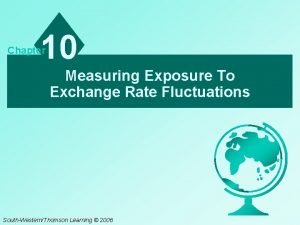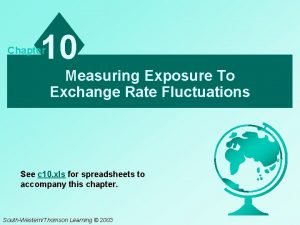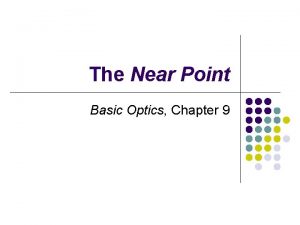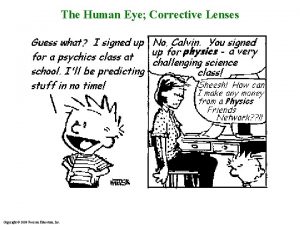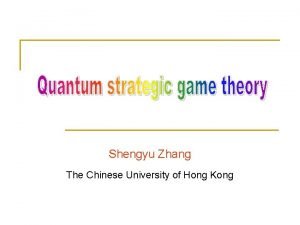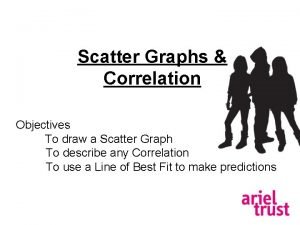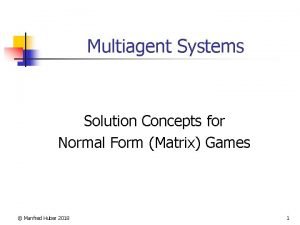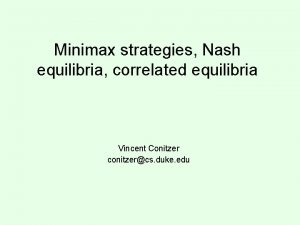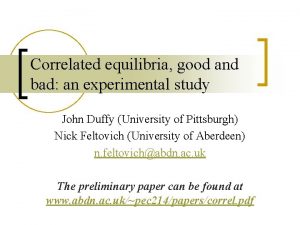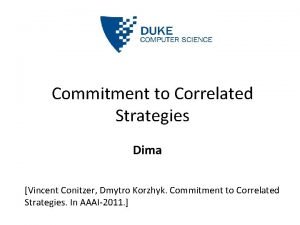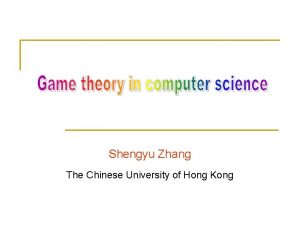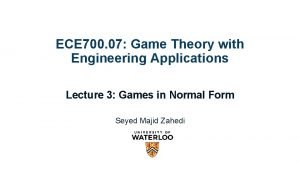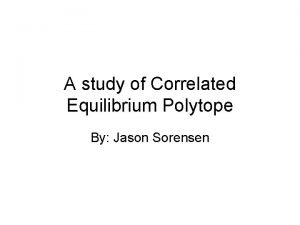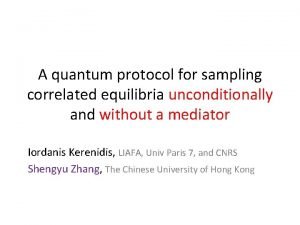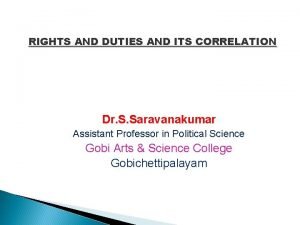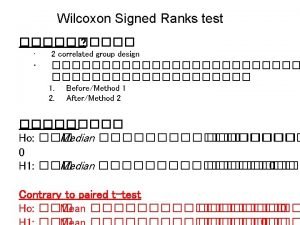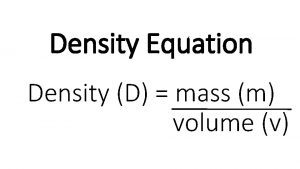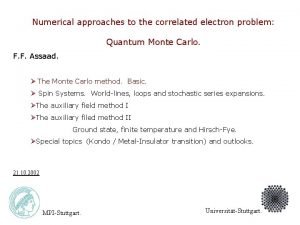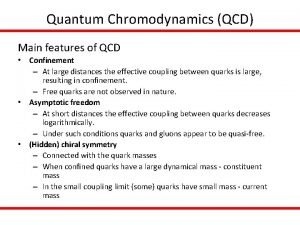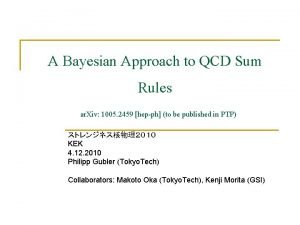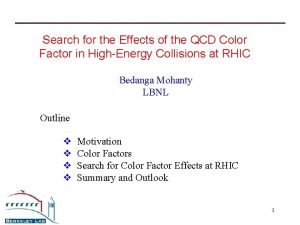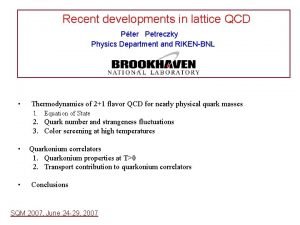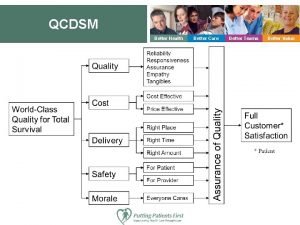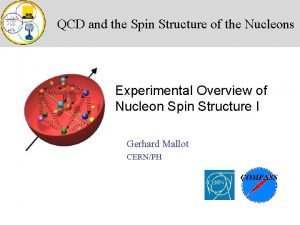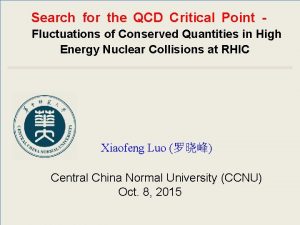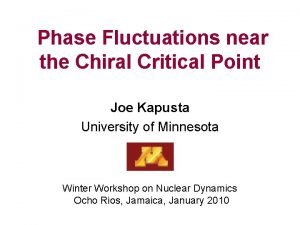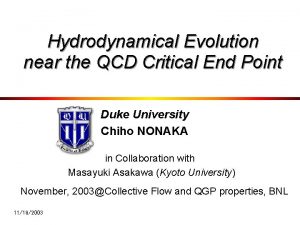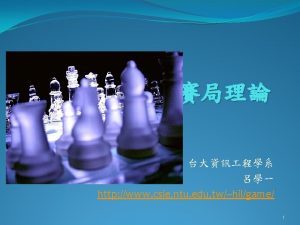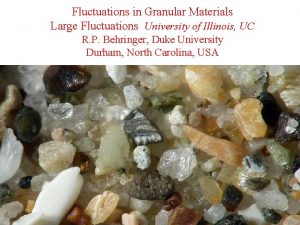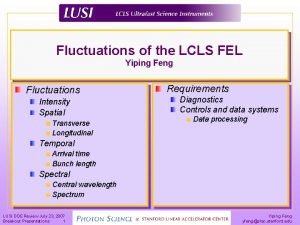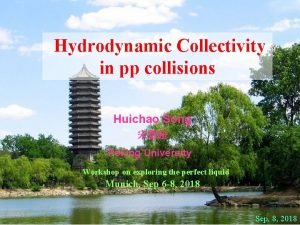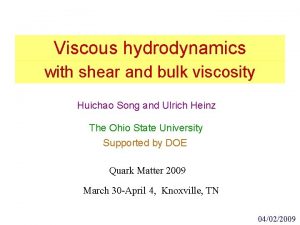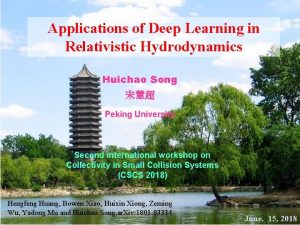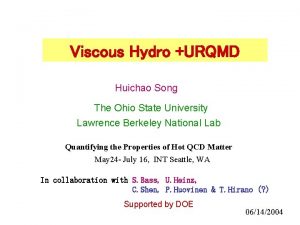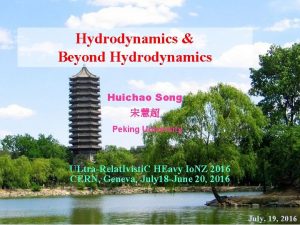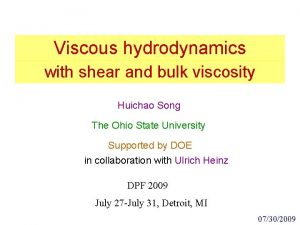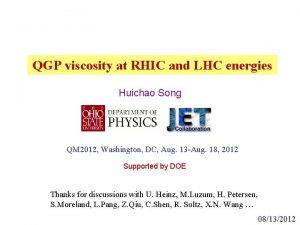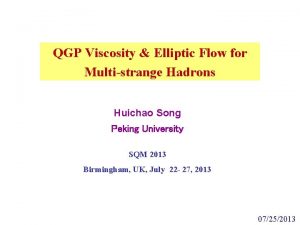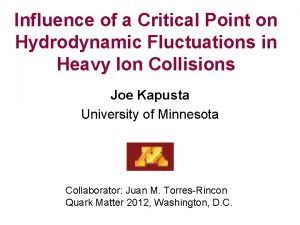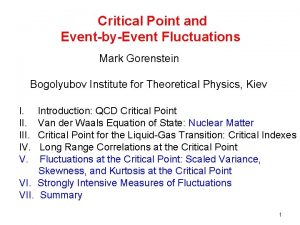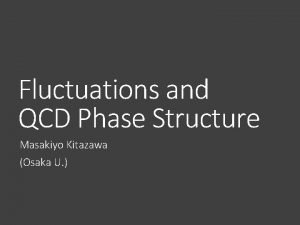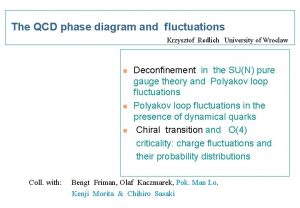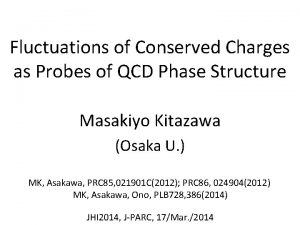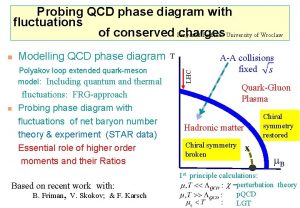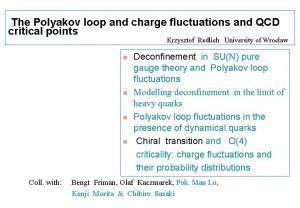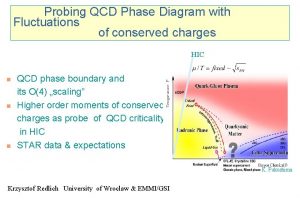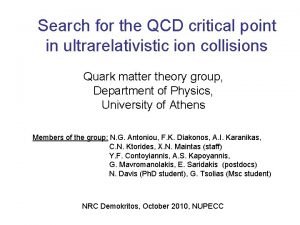Correlated Fluctuations Near the QCD critical Point Huichao
































- Slides: 32

Correlated Fluctuations Near the QCD critical Point Huichao Song 宋慧超 Peking University SQM 2015 JINR, Dubna, July 6 -11, 2015 July 9, 2015


Fluctuations & Correlations at RHIC and the LHC

Fluctuations & Correlations at RHIC and the LHC Hydro evolution

Observables for Higher Order Flow Harmonics Luzum & Ollitrault, 2012 -10 Qiu & Heinz, 12 -08 C. Gale et al. 12 -09 -Nice descriptions from e-b-e hydrodynamic simulations -They are all sensitive to the QGP viscosity

Correlated fluctuations near the QCD critical point Initial State Fluctuations -QGP fireball evolutions smear -out the initial fluctuations -uncorrelated (in general) Fluctuations near the critical point -dramatically increase near Tc -Strongly correlated

STAR BES: Cumulant ratios Xiaofeng Luo CPOD 2014 PT=(0. 4 -2) Ge. V STAR PRL 2014 PT=(0. 4 -0. 8) Ge. V

Theoretical predictions on critical fluctuations Stephanov PRL 2009 Critical Fluctuations of particles : At critical point : (infinite medium) Finite size & finite evolution time: It is important to address the effects from dynamical evolutions

Dynamical Modeling near the QCD critical point

Chiral Hydrodynamics (I) K. Paech, H. Stocker and A. Dumitru, PRC 2003 the order of the phase transition is in charged by the coupling g. order parameter quark & anti-quark is treated as the heat bath (fluid), which interact with the chiral field via effective mass

Chiral Hydrodynamics (II) K. Paech, H. Stocker and A. Dumitru, PRC 2003 (fluctuation is introduced by initial state) fluid g=3. 7 fluid g=5. 5 -Chiral fluid dynamics with dissipation & noise Nahrgang, et al. , -Chiral fluid dynamics with a Polyakov loop (PNJL) PRC 2011 Herold, et al. , PRC 2013

fluid g=3. 7 Proper treatment of freeze-out From dynamical evolution to experimental observables, it is important to properly treat the freeze-out procedure with external field

Jiang, Li & Song in preparation Correlated fluctuations along the freeze-out surface near Tc -theoretical models

Particle emissions near Tc with external field Hydro freeze-out surface Jiang, Li & Song in preparation Particle emissions in traditional hydro Particle emissions with external field

For stationary & infinite medium: --the results in Stephanov PRL 09 are reproduced

Jiang, Li & Song in preparation Hydro freezeout surface CORRELATED particle emissions along the freeze-out surface --partially include the evolution effects and volume effects

For simplicity: We assume that the correlated sigma field only influence the particle emissions near Tc, which does not influence the evolution of the bulk matter Hydro freezeout surface Input: hydro freeze-out surface; hydro has been tuned to fit d. N/dy, spectra and V 2 CORRELATED particle emissions along the freeze-out surface --partially include the evolution effects and volume effects

The choice of input parameters A. Andronic, et al. NPA (2006); M. A. Stephanov, Phys. Rev. Lett. 102, 032301 (2009); S. P. Klevansky, Rev. Mod. Phys, Vol, 64, No. 3 (1992); W. Fu, Y-x, Liu, Phys. Rev. D 79, 074011(2009); M. M. Tsypin, Phys. Rev. Lett. 73, 2015 (1994); M. M. Tsypin, Phys. Rev. B 55, 8911 (1997). ; B. Berdnikov and K. Rajagopal, Phys. Rev. D 61, 105017 (2000).

Jiang, Li & Song in preparation Correlated fluctuations along the freeze-out surface near Tc with the experimental data -comparison

STAR data vs Thermal fluctuation baselines Xiaofeng Luo CPOD 2014 PT=(0. 4 -2) Ge. V Fluctuations measured in experiment: critical fluct. + thermal fluct. + … The higher order cumulants shows large deviations from Poisson expectations

: ( Model + Poisson baselines) Jiang, Li & Song in preparation Net Protons: 0 -5% PT=(0. 4 -2) Ge. V Preliminary PT=(0. 4 -0. 8) Ge. V

C 1 C 2 C 3 C 4: Pt-(0. 4 -2) Ge. V ( Model + Poisson baselines) PT=(0. 4 -2) Ge. V Jiang, Li & Song in preparation Net Protons 0 -5% Preliminary Critical fluctuations give positive contribution to C 2 , C 3; well above the poisson baselines, can NOT explain/describe the C 2 , C 3 data

C 1 C 2 C 3 C 4 : Pt-(0. 4 -0. 8) Ge. V ( Model + Poisson baselines) PT=(0. 4 -0. 8) Ge. V Jiang, Li & Song in preparation Net Protons: 0 -5% Preliminary Critical fluctuations give positive contribution to C 2 , C 3; above the poisson baselines, can NOT explain/describe the C 2 , C 3 data

C 1 C 2 C 3 C 4: Pt-(0. 4 -2) Ge. V ( Model + Poisson baselines) PT=(0. 4 -2) Ge. V Jiang, Li & Song in preparation Net Protons 0 -5% Preliminary In this model (and also Stephanov PRL 09 framework) critical fluctuations’s contributions to C 2 , C 3 are always positive

Summary STAR BES give exiting new measurements from these net proton cumulants with p. T=(0. 4 -2) Ge. V, showing its potential of discovery the QCD critical point We calculate the correlated fluctuations along the hydro freeze-out surface near Tc through coupling the emitted particle with the fluctuating sigma field -C 4 and can be reproduced through tuning the parameters of the model -However C 2 , C 3 are well above the poisson baselines, which can NOT explain/describe data To claim the discovery of critical point, we need good theoretical models that describe both the cumulant ratios and the original cumulants C 1, C 2, C 3, C 4 Factors need to be considered in the future: -- thermal fluctuation baselines: poisson or something else? -- dynamical evolution near the critical point -- …

Thank You

Boltzmann approach with external field Stephanov PRD 2010 -analytical solution with perturbative expansion, please refer to Stephanov PRD 2010 Stationary solution for the Boltamann equation with external field Effective particle mass:

STAR data vs Thermal fluctuation baselines (II) Xiaofeng Luo CPOD 2014 Fluctuations measured in Experiment: critical fluct. + thermal fluct. + … The binomial distributions (BD) better describe the data than Poisson, but still show large deviations for C 3 and C 4 at lower collision energies.

Jiang, Li & Song in preparation Correlated fluctuations along the freeze-out surface near Tc with the experimental data -comparison A) Model + Poisson baselines B) Model + Binomial baselines

: ( Model + Binomial baselines) Net Protons: 0 -5% Jiang, Li & Song in preparation PT=(0. 4 -2) Ge. V Preliminary PT=(0. 4 -0. 8) Ge. V PT=(0. 4 -2) Ge. V PT=(0. 4 -0. 8) Ge. V

C 1 C 2 C 3 C 4 : P -(0. 4 -2) Ge. V ( Model + Binomial baselines) T Net Protons 0 -5% Jiang, Li & Song in preparation Preliminary Critical fluctuations give positive contribution to C 2 , C 3; well above the binomial baselines, can NOT explain/describe the C 2 , C 3 data

C 1 C 2 C 3 C 4 : P -(0. 4 -0. 8) Ge. V ( Model + Binomial baselines) T Net Protons: 0 -5% Jiang, Li & Song in preparation Preliminary Critical fluctuations give positive contribution to C 2 , C 3; above the binomial baselines, can NOT explain/describe the C 2 , C 3 data
 Critical semi critical and non critical instruments
Critical semi critical and non critical instruments Semi-critical
Semi-critical Difference between pulse doppler radar and mti radar
Difference between pulse doppler radar and mti radar Measuring exposure to exchange rate fluctuations
Measuring exposure to exchange rate fluctuations Short run economic fluctuations
Short run economic fluctuations Measuring exposure to exchange rate fluctuations
Measuring exposure to exchange rate fluctuations Exchange rate fluctuations
Exchange rate fluctuations Far point near point
Far point near point Far point near point
Far point near point Correlated equilibrium
Correlated equilibrium How to draw line of best fit
How to draw line of best fit Correlated equilibrium
Correlated equilibrium Correlated equilibrium
Correlated equilibrium Correlated equilibrium
Correlated equilibrium Correlated equilibrium
Correlated equilibrium Correlated equilibrium
Correlated equilibrium Correlated group design
Correlated group design Dominant strategy
Dominant strategy Correlated equilibrium
Correlated equilibrium Correlated equilibrium
Correlated equilibrium Rights and duties are correlated
Rights and duties are correlated Correlated group design
Correlated group design How to find mass with density and volume
How to find mass with density and volume The future of the correlated electron problem
The future of the correlated electron problem Correlated curriculum
Correlated curriculum Seattle seahawks tackling drills
Seattle seahawks tackling drills Qcd confinement
Qcd confinement Qcd sum rules
Qcd sum rules Color factor qcd
Color factor qcd Qcd
Qcd Qcdsm examples
Qcdsm examples Qcd lagrangian
Qcd lagrangian Qcd
Qcd



